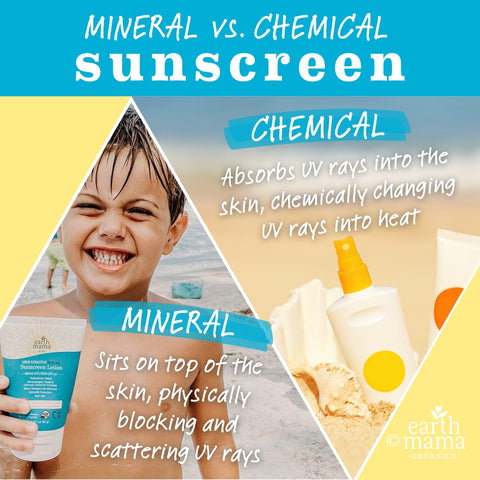
Before we discuss what specific sunscreen ingredients to avoid, let’s learn a little more about what makes a sunscreen safe.
What you might not know is that the FDA considers sunscreen an over-the-counter drug. This might sound a little weird, but actually, it’s not, considering they define a drug as “anything that’s intended to diagnose, cure, mitigate or prevent disease.” Since sunscreen uses active ingredients to protect skin against sun damage in a variety of forms, it’s considered a drug you can purchase without a prescription.
And it’s the FDA’s job to know if a drug — like sunscreen — is safe for chronic, long-term use.
So, when it comes to sunscreen, what’s safe?
Recently, the FDA determined that zinc oxide and titanium dioxide are the only two sunscreen active ingredients considered Generally Regarded As Safe and Effective (GRASE). These are both mineral-based active ingredients, and out of the 16 active ingredients commonly used in sunscreens, only mineral ingredients have enough data for the FDA to consider them safe. The rest are chemical, which we will talk about in a second.
After revisiting these active ingredients through the lens of modern-day regulations, FDA scientists now recognize more research is needed on the safety of sunscreen chemicals.

What’s the difference between mineral and chemical sunscreen?
So, when you’re looking at the active ingredients in your sunscreen use, there are only two possibilities: chemical or mineral.
On the surface, here’s the most obvious difference: mineral sunscreen is a simpler, less fussy form of sun protection, but the differences go deeper than that. Deeper than skin-deep, even.
Most importantly, Chemical sunscreen is very easily absorbed. Research shows that chemical UV filters don’t stop at the skin; in fact, they travel into systemic circulation. Chemical sunscreens — especially oxybenzone — have been in found in blood plasma, urine, the placenta and even breast milk. And they’re lipophilic — meaning they like to accumulate in fat tissue and hang out there — and can easily breach the blood-brain barrier.
Now think about this: 25% of sunscreen is not absorbed by skin. So in a pool, lake, river or ocean, that 25% gets released into the water after 20 minutes. In natural bodies of water, that’s toxic to marine life, reefs included, which is why ensuring your sunscreen is reef-safe in so important. But for humans, it’s even worse in a pool; chemical sunscreen simply contaminates the pool water, and reacts questionably with chlorine. Over time, this can reach potentially toxic levels in pool water — especially in plastic outdoor pools. Gross.

What you need to need to know about oxybenzone
Oxybenzone has a hazard rating of 8 out of 10 on EWG’s cosmetics database,, which if you're familiar with their database, you know the higher the number, the worse the ingredient. The Centers for Disease Control (CDC) routinely finds 96% of people tested have oxybenzone in their urine. This is troubling, because a 2016 study in the Journal of Environmental Research and Public Health showed that exposure to oxybenzone induces various hormone disrupting effects, like mimicking estrogen and acting as an anti-androgenic (it’ll decrease testosterone).
Translation: oxybenzone throws the endocrine system out of whack, and messes with hormones.
It's no surprise that the American Academy of Pediatricians advises against using a sunscreen containing oxybenzone. Because hormone disruption.
It's important to note that oxybenzone doesn’t act alone. It’s one of the ingredients under review by the FDA, but it has a few accomplices. Oxybenzone has to partner up with other UV filters that have been shown to have adverse health effects, like avobenzone, octinoxate, octocrylene or ecamsule.
Why mineral sunscreens are the best choice for your family’s sun protection
Unlike chemicals sunscreens, mineral sunscreens are made with zinc oxide and titanium dioxide and are not likely to be absorbed, especially if they are larger, non-nano particle size.
In fact, zinc oxide is the safest available sunscreen ingredient, and is unique as the only active ingredient providing true broad spectrum protection – UVA1, UVA2, and UVB. It’s also the only FDA-approved Broad Spectrum UVA/UVB protector.
However, not all mineral sunscreens are created equal, so be sure and read the entire ingredient label. And when in doubt, go with the ray-fighting coat of armor that is mineral sunscreen. Your body — and the planet — will thank you.
LEARN MORE



